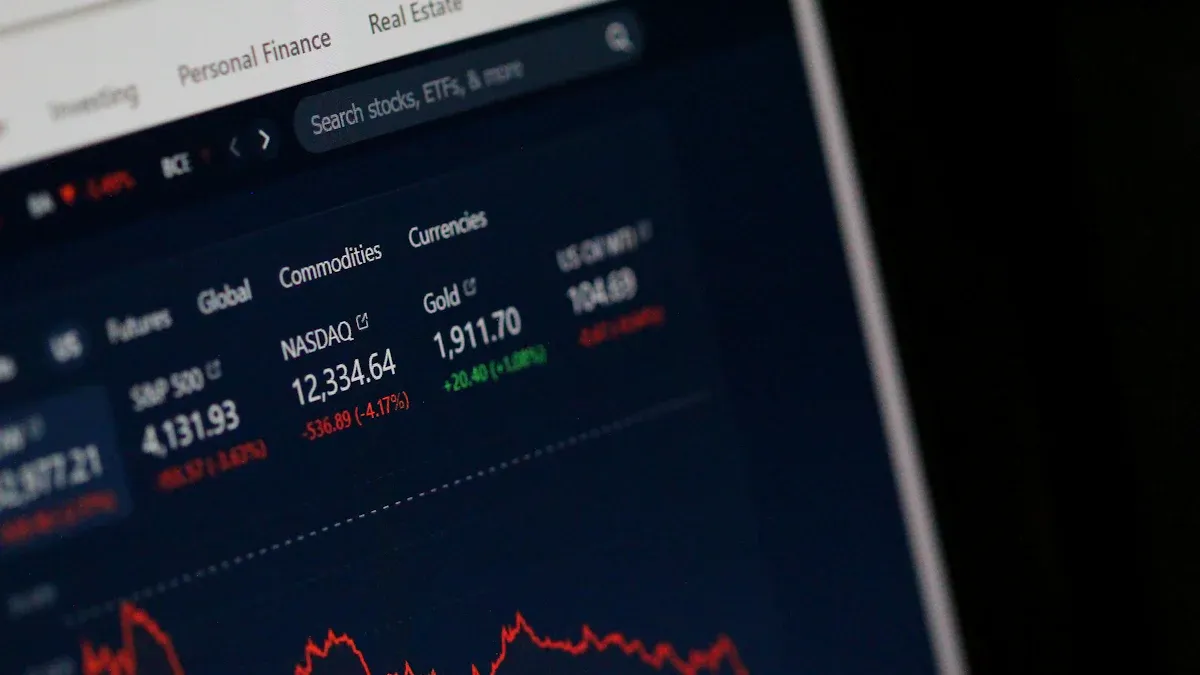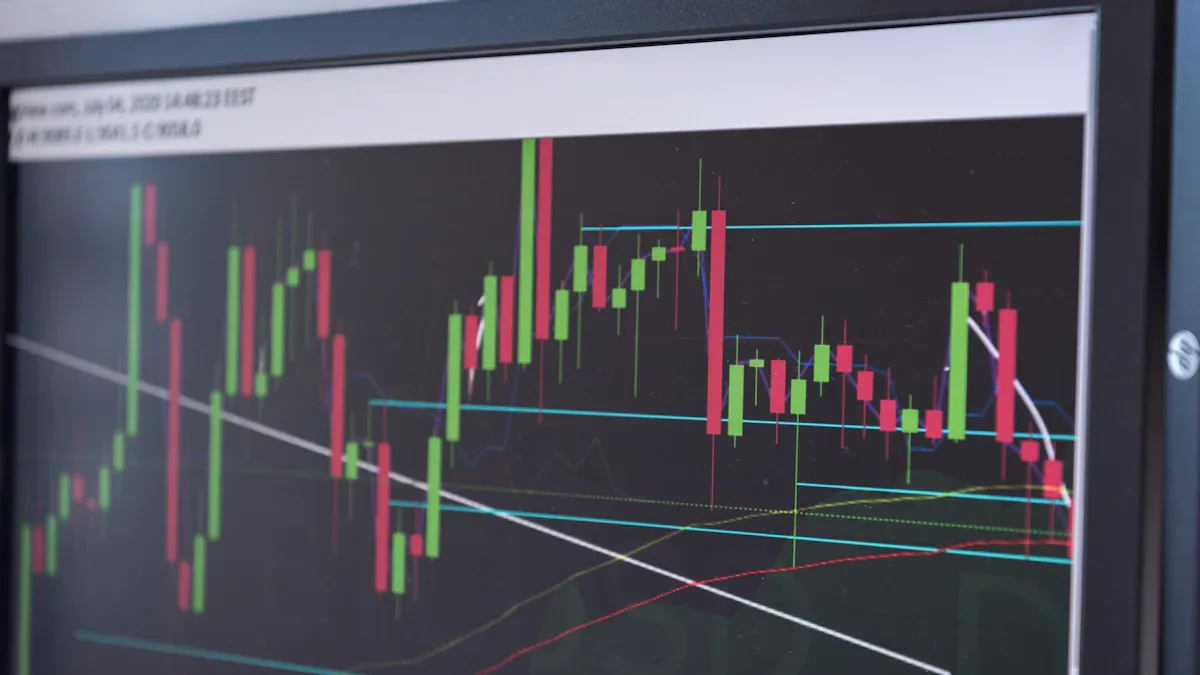- EasyCard
- Trade
- Help
- Announcement
- Academy
- SWIFT Code
- Iban Number
- Referral
- Customer Service
- Blog
- Creator
Beginner’s Guide to Spot Month Futures | How to Choose Contract Months and Master Market Volatility

Image Source: pexels
When you first encounter spot month futures, you may wonder how to choose the contract month. For example, if you want to participate in short-term fluctuations of the Hang Seng Index, you would typically choose spot month futures because their prices are closest to the spot market. Market leverage data shows that when volatility increases, trading volume and risks also rise simultaneously. You must set stop-loss points and decisively address the risks brought by high-leverage products to effectively manage potential losses.
Key Points
- Spot month futures are futures contracts that expire in the current month, with prices closest to the spot market, suitable for short-term trading and risk hedging.
- When choosing contract months, consider liquidity, risk tolerance, and contract expiration dates; beginners are recommended to prioritize high-liquidity spot month contracts.
- The leverage effect can amplify both profits and risks, so it’s essential to set stop-loss points and strictly control losses to avoid significant losses due to market volatility.
- Trading sessions affect liquidity and volatility; daytime sessions have the best liquidity, while nighttime sessions have higher volatility and risks, requiring cautious operations.
- Mastering market volatility requires monitoring economic data and technical indicators, combining multiple tools to judge trends, and continuously learning and reviewing trading strategies.
Spot Month Futures Concept
Definition and Characteristics
When learning about futures, you first need to understand what spot month futures are. Spot month futures refer to futures contracts that expire in the current month. These contracts’ prices are usually closest to the spot market. For example, if today is June, the spot month futures you trade are contracts expiring in June. These contracts’ prices quickly reflect market sentiment as the spot price of the Hang Seng Index fluctuates.
When you choose spot month futures, you can more flexibly participate in short-term fluctuations. Because spot month contracts have the highest trading volume and the best liquidity, you can easily find buyers or sellers, reducing costs from bid-ask spreads. Spot month futures have larger price fluctuations, making them suitable for short-term trading or hedging spot market risks.
Tip: When choosing spot month futures, you should pay attention to the contract’s expiration date. As the expiration date approaches, prices align more closely with the spot market, and volatility increases.
Zero-Sum Game and Leverage Effect
When participating in spot month futures, you must understand that this is a zero-sum game. Every dollar you earn comes from another participant’s loss. The total profits and losses in the market sum to zero. This characteristic makes the futures market highly competitive, requiring you to have a clear trading strategy.
Spot month futures also have an important feature: the leverage effect. You only need to pay a portion of the margin (e.g., 10% of the contract value) to trade a larger contract value. For example, a contract worth USD 10,000 requires only USD 1,000 as margin (assuming an exchange rate of 1 USD = 7.8 HKD). This amplifies your potential returns and risks.
- Leverage Advantage: You can participate in larger-scale markets with less capital.
- Leverage Risk: If the market moves against you, your losses are amplified, potentially exceeding the initial margin.
As a beginner, you should pay special attention to the risks brought by leverage. You need to set stop-loss points and strictly control the maximum loss per trade. This ensures long-term survival in the spot month futures market.
Choosing Contract Months

Image Source: unsplash
Contract Types
When choosing futures contracts, you will find different contract months available in the market. The most common are spot month contracts, next-month contracts, and quarterly contracts. Each type has distinct characteristics and use cases:
| Contract Type | Expiration Date | Liquidity | Suitable For |
|---|---|---|---|
| Spot Month Contract | Third Thursday of the current month | Highest | Short-term trading, spot hedging |
| Next-Month Contract | Third Thursday of the next month | Relatively high | Medium-short term strategies |
| Quarterly Contract | March, June, September, December | Lower | Long-term strategies, hedging |
If you want to participate in short-term fluctuations, you usually choose spot month futures. These contracts have the highest trading volume and prices closest to the spot market. Next-month and quarterly contracts are suitable for medium- to long-term strategies or locking in future prices. However, these contracts have lower liquidity than spot month contracts, potentially leading to wider bid-ask spreads.
Selection Principles
When choosing contract months, you should consider the following key points:
- Risk Tolerance: If you’re a beginner, start with high-liquidity spot month contracts. This allows easier market entry and exit, reducing slippage risks.
- Liquidity: Near-month contracts (spot and next-month) have high trading volumes, making it easier to find counterparties and lowering transaction costs. Far-month contracts have lower trading volumes, which may widen bid-ask spreads and increase costs.
- Expiration Date: Pay attention to the contract’s expiration date to avoid rolling over too close to settlement, as trading volume decreases on settlement day, reducing liquidity and increasing the risk of price anomalies.
- Margin Requirements: Near-month contracts have lower margin requirements, but during high market volatility, daily price swings may approach or exceed the minimum margin, increasing the risk of forced liquidation.
Tip: You should roll over to the next contract a few days before expiration to avoid increased transaction costs due to low liquidity.
Trading Sessions and Liquidity
When participating in futures trading, you also need to understand how different trading sessions affect price volatility. The Hong Kong futures market is divided into daytime and nighttime sessions:
- Daytime Session: 9:15 AM to 12:00 PM, 1:00 PM to 4:30 PM. This period has the highest trading volume, best liquidity, and more noticeable price fluctuations.
- Nighttime Session: 5:15 PM to 3:00 AM. Nighttime trading volume is lower than daytime, but volatility spikes during major international news or when US markets open.
If you prefer high liquidity and lower transaction costs, you should trade during daytime sessions. Nighttime sessions offer opportunities to capture international news-driven movements but have lower liquidity, leading to wider bid-ask spreads.
Note: When trading at night, pay special attention to margin and price gap risks to avoid unnecessary losses due to low liquidity.
Market Volatility

Image Source: pexels
Sources of Volatility
When participating in the futures market, you will notice frequent significant price fluctuations. These fluctuations mainly stem from economic data, policy announcements, and international market changes. Here are some common economic statistics examples:
- Buffett Indicator: As of the end of June 2024, the US stock market’s Buffett Indicator reached 192.24%, indicating asset price bubble risks.
- US Economic Growth Forecast: The Federal Reserve and IMF have raised growth forecasts for the US and global economies for 2024–2026, reflecting the close relationship between economic fundamentals and market performance.
- Labor Market Data: Annual hourly wage growth is around 4%, higher than pre-pandemic averages, impacting inflation and monetary policy.
- Bond Yield Curve: The yield curve between 2-year and 10-year Treasury notes reflects market expectations for economic cycles, with an inverted curve typically increasing market volatility.
You should closely monitor these data points, as they directly affect futures prices.
Contango and Backwardation
When observing futures, you will notice that futures prices are sometimes higher than the spot price (contango) or lower (backwardation). Contango often reflects market expectations of future positive news or high funding costs. Backwardation may occur due to market pessimism or as settlement approaches, prompting investors to close positions. You can use contango or backwardation to gauge market sentiment and adjust your trading strategy.
Tip: When contango or backwardation is excessive, the market may be poised for a directional breakout, so pay extra attention.
Settlement Day Impact
On contract settlement days, market volatility significantly increases. You will notice a sudden spike in trading volume, and prices are prone to anomalies. This is because many investors need to close positions or roll over, intensifying capital flows. You should plan rollovers in advance to avoid rushed actions on settlement day, reducing unnecessary risks.
Mastering Market Volatility Techniques
Observing Market Dynamics
To master market volatility, you first need to learn to observe market dynamics. You can monitor major economic data, policy announcements, and international market changes daily. These factors directly influence futures prices. You can use news platforms, brokerage quote systems, and real-time data tools to quickly grasp market sentiment. When you notice a sudden surge in trading volume or price breakouts at key support or resistance levels, these are signals of impending market volatility.
Introduction to Technical Analysis
You can use technical analysis tools to help judge market trends. Common technical indicators include volume indicators (e.g., OBV, A/D, MFI), trend indicators (e.g., moving averages, Bollinger Bands, Ichimoku Cloud), and momentum indicators (e.g., RSI, MACD, Williams %R, Momentum). Different indicators have varying reference values; for example, Williams %R above -20% indicates overbought, below -80% indicates oversold; Momentum above 0% signals strong upward strength, and below 0% signals strong downward strength; RSI below 30 with increasing volume may signal a potential market reversal.
| Volume Indicator | Paired Technical Indicator | Type | Reference and Application |
|---|---|---|---|
| OBV | RSI + Moving Averages | Momentum + Trend | Verifies momentum strength and trend direction, distinguishes true vs. false breakouts |
| A/D Indicator | MACD + Bollinger Bands | Trend + Volatility | Confirms fund inflow trends and breakout validity |
| MFI | RSI + Support/Resistance Zones | Momentum + Structure | Identifies overbought/oversold states and momentum changes at key price levels |
| OBV / A/D | Moving Average Convergence Breakout | Trend | Captures breakout after consolidation with volume surge |
| Any Volume Indicator | Multi-Indicator Convergence Strategy | Hybrid | Enhances strategy success when momentum, trend, and volume align |
Tip: You should reference multiple indicators simultaneously and maintain consistent timeframes to reduce the risk of misjudgment from a single indicator.
Judgment and Response
When judging market volatility, you can use statistical data to improve accuracy. For example, with Bollinger Bands, prices have about a 68.2% chance of falling within ±1 standard deviation, 95.4% within ±2 standard deviations, and 99% within ±3 standard deviations. These data help you determine if prices are in extreme ranges, allowing you to adjust your trading strategy.
| Standard Deviation Range | Probability of Price Occurrence |
|---|---|
| ±1σ | Approx. 68.2% |
| ±2σ | Approx. 95.4% |
| ±3σ | Approx. 99% |
When prices approach the upper or lower Bollinger Bands, combine volume and momentum indicators to judge whether a false breakout or trend reversal is occurring. When multiple indicators signal simultaneously, your judgment accuracy increases significantly. You should establish your own observation and response process, consistently record and review trading experiences to improve continuously in the market.
Trading Steps and Risk Management
Account Opening and Margin
To participate in futures trading, you first need to open a futures account. You need to choose a qualified brokerage or futures company; currently, Hong Kong has 71 securities firms and 10 futures companies with relevant qualifications. The account opening process is strict, and some options accounts even require passing Level 1 and Level 3 exams, with full video monitoring. You must complete the exams yourself, as proxies are not allowed. During account opening, the brokerage will require identification, proof of address, and financial status documents. You also need to deposit a margin, typically around 10% of the contract value. For example, a USD 10,000 contract requires about USD 1,000 in margin (calculated at 1 USD = 7.8 HKD). Trading also involves costs like commissions and exchange fees.
Tip: You should compare the services and fees of different brokerages to choose the most suitable platform.
Stop-Loss and Risk Control
When trading futures, setting stop-loss points is critical. When losses reach 2% of total capital, you should decisively stop losses to prevent further expansion. You must strictly adhere to trading discipline and avoid deviating from your strategy due to fear or greed. The leverage effect amplifies profits and losses, so capital management must be cautious. You can set stop-loss orders or pre-calculate the maximum acceptable loss per trade. Continuous learning and self-training help improve your risk control capabilities.
Common Mistakes
Common mistakes beginners make in futures trading include:
- Placing orders randomly without a clear plan
- Not setting stop-loss points, leading to amplified losses
- Over-relying on black-box systems, ignoring market changes
- Emotional trading, resulting in small gains and large losses
- Lack of discipline, failing to consistently review strategies
These mistakes reflect human weaknesses and can lead to bankruptcy. You should maintain comprehensive trading records, periodically review and refine strategies. Algorithmic trading and performance backtesting can help overcome emotional influences and improve trading discipline. Continuous education and self-training are key to long-term stable profits.
By learning to choose appropriate contract months, you can more effectively participate in the spot month futures market. You must always prioritize risk management, set stop-loss points, and avoid loss escalation. Simulated trading can help improve your skills; according to tests, about 30% of beginners can outperform long-term holding strategies in simulated trading. You should make extensive use of simulation platforms and continuously learn market information. You can refer to resources from the Hong Kong Stock Exchange, brokerage tutorials, and professional books to make your journey in spot month futures trading more robust.
FAQ
What are spot month futures?
Spot month futures are futures contracts expiring in the current month. You can use them to participate in short-term market fluctuations, with prices closest to the spot market.
How to choose contract months?
You should choose based on your trading goals and risk tolerance. Spot month contracts are recommended for short-term trading, while quarterly contracts suit long-term strategies.
What are the main risks in futures trading?
You face leverage risks and market volatility. Setting stop-loss points and strict capital management help reduce losses.
How much capital is needed for futures trading?
You only need to pay about 10% of the contract value as margin. For example, a USD 10,000 contract requires about USD 1,000 in margin (calculated at 1 USD = 7.8 HKD).
How does settlement day affect prices?
Settlement days see increased trading volume and heightened price volatility. You should plan rollovers in advance to avoid closing positions on settlement day.
Futures trading volatility and leverage risks, coupled with complex fund tracking and technical analysis, plus high barriers to account setup and trading, limit efficiency, while restricted flexible savings independently curb fund utilization. BiyaPay, an all-in-one financial platform, simplifies processes for instant US and HK stock and derivatives investments, empowering you to seize global market opportunities. Remittance fees are as low as 0.5%, covering 190+ countries with same-day transfers. Its flexible savings offer a 5.48% annualized return, with daily interest credited automatically and anytime withdrawals, supporting 30+ fiat and 200+ cryptocurrencies, secured by KYC.
Explore BiyaPay today to launch your global wealth journey! Join BiyaPay for streamlined fund management!
*This article is provided for general information purposes and does not constitute legal, tax or other professional advice from BiyaPay or its subsidiaries and its affiliates, and it is not intended as a substitute for obtaining advice from a financial advisor or any other professional.
We make no representations, warranties or warranties, express or implied, as to the accuracy, completeness or timeliness of the contents of this publication.




Contact Us
Company and Team
BiyaPay Products
Customer Services
is a broker-dealer registered with the U.S. Securities and Exchange Commission (SEC) (No.: 802-127417), member of the Financial Industry Regulatory Authority (FINRA) (CRD: 325027), member of the Securities Investor Protection Corporation (SIPC), and regulated by FINRA and SEC.
registered with the US Financial Crimes Enforcement Network (FinCEN), as a Money Services Business (MSB), registration number: 31000218637349, and regulated by FinCEN.
registered as Financial Service Provider (FSP number: FSP1007221) in New Zealand, and is a member of the Financial Dispute Resolution Scheme, a New Zealand independent dispute resolution service provider.




















